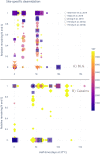Assessing the degradation of ancient milk proteins through site-specific deamidation patterns
- PMID: 33833277
- PMCID: PMC8032661
- DOI: 10.1038/s41598-021-87125-x
Assessing the degradation of ancient milk proteins through site-specific deamidation patterns
Erratum in
-
Author Correction: Assessing the degradation of ancient milk proteins through site-specific deamidation patterns.Sci Rep. 2022 Feb 1;12(1):2016. doi: 10.1038/s41598-022-06151-5. Sci Rep. 2022. PMID: 35105919 Free PMC article. No abstract available.
Abstract
The origins, prevalence and nature of dairying have been long debated by archaeologists. Within the last decade, new advances in high-resolution mass spectrometry have allowed for the direct detection of milk proteins from archaeological remains, including ceramic residues, dental calculus, and preserved dairy products. Proteins recovered from archaeological remains are susceptible to post-excavation and laboratory contamination, a particular concern for ancient dairying studies as milk proteins such as beta-lactoglobulin (BLG) and caseins are potential laboratory contaminants. Here, we examine how site-specific rates of deamidation (i.e., deamidation occurring in specific positions in the protein chain) can be used to elucidate patterns of peptide degradation, and authenticate ancient milk proteins. First, we characterize site-specific deamidation patterns in modern milk products and experimental samples, confirming that deamidation occurs primarily at low half-time sites. We then compare this to previously published palaeoproteomic data from six studies reporting ancient milk peptides. We confirm that site-specific deamidation rates, on average, are more advanced in BLG recovered from ancient dental calculus and pottery residues. Nevertheless, deamidation rates displayed a high degree of variability, making it challenging to authenticate samples with relatively few milk peptides. We demonstrate that site-specific deamidation is a useful tool for identifying modern contamination but highlight the need for multiple lines of evidence to authenticate ancient protein data.
Conflict of interest statement
The authors declare no competing interests.
Figures








Similar articles
-
Trends in deamidation across archaeological bones, ceramics and dental calculus.Methods. 2022 Apr;200:67-79. doi: 10.1016/j.ymeth.2021.08.004. Epub 2021 Aug 25. Methods. 2022. PMID: 34450289
-
Direct evidence of milk consumption from ancient human dental calculus.Sci Rep. 2014 Nov 27;4:7104. doi: 10.1038/srep07104. Sci Rep. 2014. PMID: 25429530 Free PMC article.
-
Palaeoproteomic identification of breast milk protein residues from the archaeological skeletal remains of a neonatal dog.Sci Rep. 2019 Sep 6;9(1):12841. doi: 10.1038/s41598-019-49183-0. Sci Rep. 2019. PMID: 31492911 Free PMC article.
-
Peptides from milk proteins and their properties.Crit Rev Food Sci Nutr. 2003;43(6):607-33. doi: 10.1080/10408690390251138. Crit Rev Food Sci Nutr. 2003. PMID: 14669880 Review.
-
Structures and functionalities of milk proteins.Crit Rev Food Sci Nutr. 1996 Dec;36(8):807-44. doi: 10.1080/10408399609527751. Crit Rev Food Sci Nutr. 1996. PMID: 8989511 Review.
Cited by
-
Paleoproteomic evidence reveals dairying supported prehistoric occupation of the highland Tibetan Plateau.Sci Adv. 2023 Apr 14;9(15):eadf0345. doi: 10.1126/sciadv.adf0345. Epub 2023 Apr 12. Sci Adv. 2023. PMID: 37043579 Free PMC article.
-
Deep palaeoproteomic profiling of archaeological human brains.PLoS One. 2025 May 28;20(5):e0324246. doi: 10.1371/journal.pone.0324246. eCollection 2025. PLoS One. 2025. PMID: 40435004 Free PMC article.
-
Dairying enabled Early Bronze Age Yamnaya steppe expansions.Nature. 2021 Oct;598(7882):629-633. doi: 10.1038/s41586-021-03798-4. Epub 2021 Sep 15. Nature. 2021. PMID: 34526723 Free PMC article.
-
Detection of dairy products from multiple taxa in Late Neolithic pottery from Poland: an integrated biomolecular approach.R Soc Open Sci. 2023 Mar 15;10(3):230124. doi: 10.1098/rsos.230124. eCollection 2023 Mar. R Soc Open Sci. 2023. PMID: 36938542 Free PMC article.
-
Count Dracula Resurrected: Proteomic Analysis of Vlad III the Impaler's Documents by EVA Technology and Mass Spectrometry.Anal Chem. 2023 Aug 29;95(34):12732-12744. doi: 10.1021/acs.analchem.3c01461. Epub 2023 Aug 8. Anal Chem. 2023. PMID: 37552208 Free PMC article.
References
-
- Craig OE, et al. Did the first farmers of central and eastern Europe produce dairy foods? Antiquity. 2005;79:882–894.
-
- Evershed RP, et al. Earliest date for milk use in the Near East and southeastern Europe linked to cattle herding. Nature. 2008;455:528–531. - PubMed
-
- Dunne J, et al. First dairying in green Saharan Africa in the fifth millennium BC. Nature. 2012;486:390–394. - PubMed
Publication types
MeSH terms
Substances
Grants and funding
LinkOut - more resources
Full Text Sources
Other Literature Sources
Molecular Biology Databases

